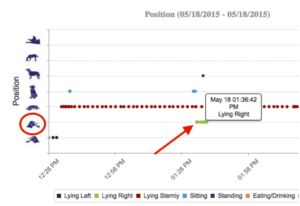Patient Condition and History
Jade, a 4-year-old spayed female Chihuahua mixed dog weighing 15 lbs, was hospitalized for close observation after she was hit by a car. She was breathing heavily, which raised the clinical suspicion of an internal chest injury, and was placed in a sternal position, lying on her belly. If allowed to lie on her side, she became distressed and dyspneic (dyspnea = labored or difficult breathing).
When a patient is suffering from dyspnea, fundamental medical care involves easing the mechanical effort of ventilation through optimal body positioning. When lying on its side, an animal’s body weight pushes down on the lungs on the underside, limiting their ability to expand and take in oxygen. While this limitation is negligible for a healthy resting dog or cat, it may become life-threatening when the pet is sick and already struggling to breathe.
A PetPace smart collar was placed on Jade to help keep her lying on her belly, and preventing her breathing from deteriorating if she rolled on her side.
Monitoring Data
The PetPace proprietary algorithm continuously produces a minuteby-minute readings of dogs’ body postures. As can be seen from the graphs below, Jade spent most of her time lying on her belly. As can also be seen, the brief occasions when she turned onto her side were accompanied by acute increases in respiratory rate, indicating distress.
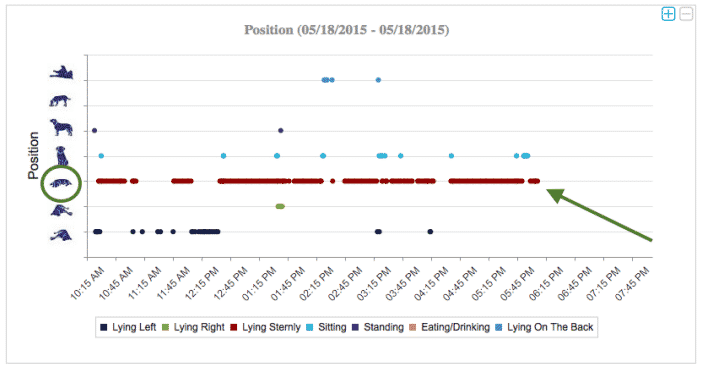
* JADE’S POSITION CHART SHOWING HER PREDOMINANTLY LYING ON HER STOMACH.
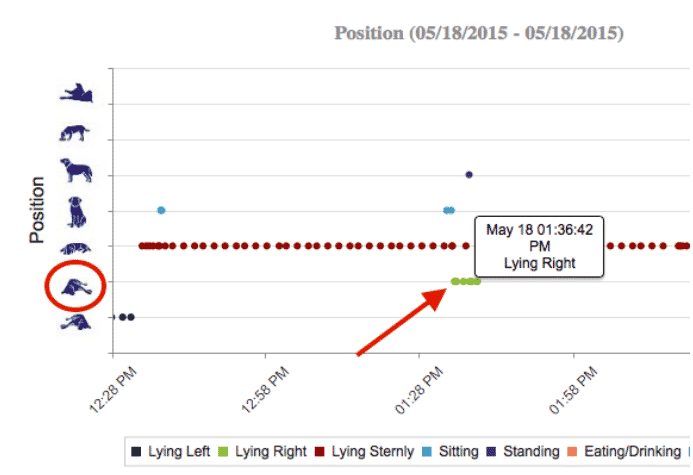
*CLOSE-UP VIEW OF A POSTURE CHANGE EVENT, ROLLING FROM STOMACH TO SIDE.
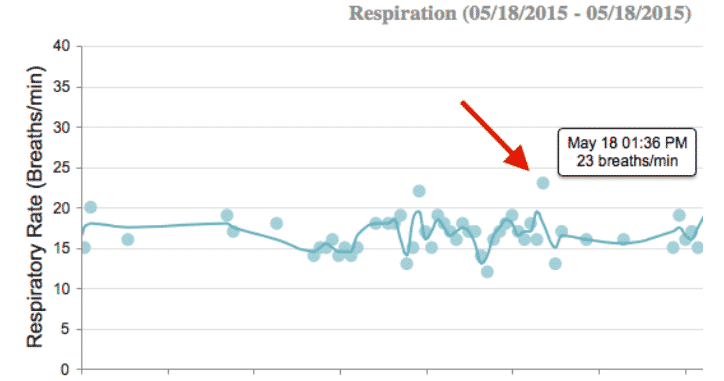
* RESPIRATION CHART (FROM THE SAME TIME AS THE POSTURE CHANGE CHART ABOVE) SHOWING ACUTE
RESPIRATORY RATE INCREASE.
The hospital staff used this real-time graphic display to alert them to Jade’s position changes. Upon receiving alerts of such an event, caretakers would immediately move her back to her belly, alleviating her labored breathing.
The activity chart also provided important supplementary information, indicating when Jade was moving and changing positions.
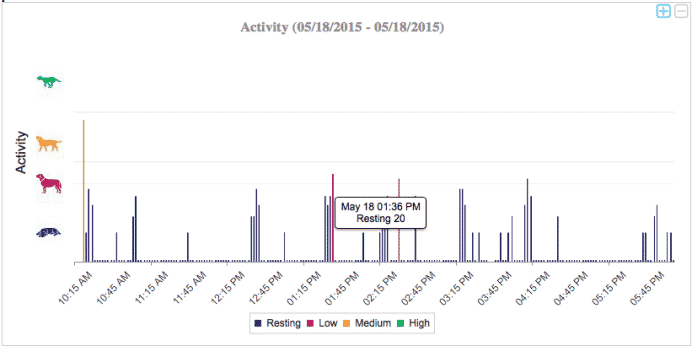
*ACTIVITY CHART SHOWING MOSTLY RESTING WITH OCCASIONAL SHORT, LOW-INTENSITY MOVEMENTS ASSOCIATED WITH POSITION CHANGES.
Discussion
Jade’s posture, respiration and activity data provided hospital staff with valuable real time indications of an impending critical health situation.
Despite best efforts, it is nearly impossible to provide all hospitalized patients with constant medical observation. Medical staff, including veterinarians and veterinary technicians, must care for multiple pets. It is often a challenge to immediately detect every change in every patient. A combination of continuous telemetric monitoring and an accessible data display helps meet this challenge.
This case demonstrates the value of real time posture monitoring in a clinical setting. This data gathered by the PetPace collar facilitated timely intervention that prevented worsening of this pet’s breathing problem, said Dr. Asaf Dagan, a specialist in canine and feline medicine and surgery, and PetPace’s Chief Veterinarian. In addition, following trends and postural habits of pets at home over time, and detecting deviations from the routine, may help in early diagnosis of conditions causing pain and discomfort, he concluded.
Conclusions
PetPace’s wearable technology allows, for the first time in veterinary medicine, continuous remote monitoring of body posture. This information can be used to improve patient care and clinical outcome, while reducing the overall burden on staff. It can also be used long term to assist in early detection of pathological conditions.
Using the PetPace collar’s position data in real time helped us give Jade better care and treatment, and contributed to the good outcome of this case, said Dr. Caitlin Tipton of Lake Wylie, SC, Jade’s veterinarian. The collar provided us with clinically valuable data quickly helping to prevent a life threatening dyspnea.

